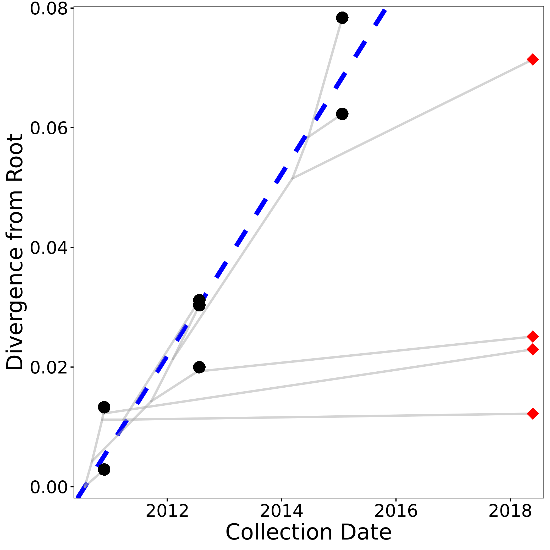Phylodating
version v1.0.1
Phylodating estimates unknown sequence ages from a phylogenetic tree inferred from longitudinally sampled sequences ("calibration sequences") and sequences with unknown ages ("query sequences") that have been isolated from the same individual. Calibration sequences are used to calibrate a linear regression that relates the root-to-tip distances of these sequences to their sampling times, which is then used to estimate the establishment dates of the query sequences. The methodology was developed to estimate the integration dates of HIV DNA sequences persisting in the reservoir, as described in:
Jones, B. R., et al. (2018) Phylogenetic approach to recover integration dates of latent HIV sequences within-host. PNAS 115 (38): E8958-E8967. doi: 10.1073/pnas.1802028115.
To estimate integration dates of HIV reservoir sequences, you must provide two files. First, you must provide a single unrooted phylogenetic tree inferred from plasma-derived HIV RNA sequences collected over at least 3 time points prior to therapy initiation ("calibration sequences") along with HIV sequences collected from the reservoir ("query sequences"). The latter may comprise proviral sequences collected during suppressive therapy, or HIV sequences sampled following treatment discontinuation (under the assumption that these represent sequences emerging from the reservoir). Second you must provide an "info" CSV file listing each sequence in the phylogeny, its sampling date, and specifying whether the sequence should be treated as "calibration" (i.e. data used to calibrate the linear regression; coded as "0") or "query" (sequences for which date estimation is required; coded as "1"). Note that collection date is required for all sequences, even query sequences, if you want to generate the divergence versus time plot. Additional details of these two input files are given below.
We take security and confidentiality very seriously. Please, DO NOT upload sequence data to Phylodating, and ensure that your phylogenies and input files DO NOT contain personally identifying information. Data generated by Phylodating will deleted from our servers after 7 days.
Phylodating generates four files: a newick file containing a rooted version of the input tree, a csv file containing information on the linear model parameters and model fitness, a csv file containing the estimated dates and a divergence versus time plot of the sequences. If the data contains a sufficient molecular clock signal to perform the linear regression then the Model Fit column of the stats.csv file will be 1 and the divergence versus time plot will be created; otherwise the Model Fit column of the stats.csv file will be 0 and the divergence versus time plot will not be created. Details of the four files produced by Phylodating (rooted_tree.nwk, stats.csv, data.csv, divergence_vs_time.pdf) are given below.
Outputs:
Phylodating produces a zipped archive containing four files, as follows.
rooted_tree.nwk
A rooted version of the input tree, where the root is chosen to maximize the correlation between sampling time of calibration sequences and their divergence from the root.
Example:
(((DNA1:0.010733,RNA1:0.001053):0.001021,(RNA2:0.007126,((DNA2:0.005841,RNA3:0.000712):0.004969,(RNA4:0.008952,(DNA4:0.019875,(RNA6:0.003845,RNA7:0.01993):0.006931):0.030149):0.007087):0.010048):0.00697):0.01418479131,(RNA5:0.019962,DNA3:0.001):0.02586320869);
stats.csv
A comma separated file that contains information about the linear regression performance and parameters. The columns included are:
RunID- run ID of the job created by Phylodating.dAIC- difference between the Akaike Information Criteria of the null model (where the regression’s slope is zero) and the linear regression inferred from the data.EstimateRootDate- estimated root date of the tree calculated by the linear regression in the format yyyy-mm-dd.EstimatedRootDate95Low- lower bound of the 95% confidence interval of the estimated root date in the format yyyy-mm-dd.EstimatedRootDate95High- upper bound of the 95% confidence interval of the estimated root date in the format yyyy-mm-dd.EstimatedEvolutionaryRate- estimated evolutionary rate calculated by the linear regression in substitutions per site per day.Fit- the model fit. Designated as1if the linear regression passes both predefined quality control criteria (dAIC > 10, and the lower bound of the 95% confidence interval of the estimated root date precedes the earliest collection date) and0otherwise.
Example:
"RunID","dAIC","EstimatedRootDate","EstimatedRootDate95Low","EstimatedRootDate95High","EstimatedEvolutionaryRate","Fit"
"12528060",17.1483031836612,"2009-12-06","2008-04-08","2011-08-04",4.32745826454141e-05,1
data.csv
A comma separated file containing the estimated dates. The columns included are:
ID- the sequence ID.Date- collection date in the format yyyy-mm-dd, as indicated in the user input fileQuery-0if the sequence is used to calibrate the linear regression, and1otherwise, as indicated in the user input fileEstimatedDate- estimated date in the format yyyy-mm-dd.EstimatedDate95Low- lower bound of the 95% confidence interval of the estimated date in the format yyyy-mm-dd.EstimatedDate95High- upper bound of the 95% confidence interval of the estimated date in the format yyyy-mm-dd.
Example:
"ID","Date","Query","EstimatedDate","EstimatedDate95Low","EstimatedDate95High"
"DNA1","2018-09-05",1,"2011-07-28","2010-02-19","2013-01-02"
"DNA3","2018-09-05",1,"2011-08-18","2010-03-14","2013-01-21"
"DNA2","2018-09-05",1,"2012-08-02","2011-03-22","2013-12-15"
"DNA4","2018-09-05",1,"2015-07-08","2013-12-21","2017-01-23"
"RNA1","2011-03-08",0,"2010-12-16","2009-06-15","2012-06-18"
"RNA2","2011-03-08",0,"2011-09-20","2010-04-19","2013-02-20"
"RNA5","2012-11-05",0,"2012-10-29","2011-06-20","2014-03-11"
"RNA3","2012-11-05",0,"2012-04-06","2010-11-18","2013-08-24"
"RNA4","2012-11-05",0,"2012-12-01","2011-07-23","2014-04-12"
"RNA6","2015-05-07",0,"2014-12-10","2013-06-21","2016-05-30"
"RNA7","2015-05-07",0,"2015-12-17","2014-05-06","2017-07-28"
divergence_vs_time.pdf
A graphic relating root-to-tip divergence of the sequences versus their collection dates. Black circles represent calibration sequences and red diamonds represent query sequences. The blue dotted line denotes the linear regression and the grey lines denote the ancestral (phylogenetic) traces. An example plot is shown below.
Will only be generated if the regression fits and all tip dates are given.
Example:
